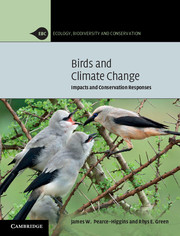Book contents
5 - Effects of climate change on distributions and communities
Published online by Cambridge University Press: 05 June 2014
Summary
Introduction
Preceding chapters have illustrated how temperature, precipitation and other climatic factors affect the breeding productivity, survival and abundance of individual bird species through a variety of mechanisms. As a result, the geographical ranges of species can frequently be well described by the climate, as illustrated with reference to the red grouse in Chapter 1, although that descriptive ability does not show for certain whether the climate has a direct influence, an indirect influence or no real influence at all on species’ distributions (Gaston 2003). There are plenty of examples of biotic factors such as prey availability (Koenig & Haydock 1999; Banko et al. 2002), competition (Terborgh 1985; Emlen et al. 1986; Gross & Price 2000) and predation (Pienkowski 1984; Dekker 1989) being the main proximate factor limiting species’ ranges, but of course, the distribution of many of those other species may also be affected by climate. For example, the northern limit of the distribution of the red fox, which is thought to restrict the range of some wader species (e.g. Pienkowski 1984), is determined by resource (food) availability and therefore ultimately determined by climate (Hersteinsson & Macdonald 1994). The northern limit of Hume’s leaf warbler Phylloscopus humei which feeds on arthropods in tree canopies, is limited by cold temperature, as this causes leaf loss and therefore reduces food availability (Gross & Price 2000). Climate is therefore often regarded as the ultimate determinant of species’ distributions and abundance, even though the precise mechanisms causing the limitation may be unclear (Huntley et al. 2007).
- Type
- Chapter
- Information
- Birds and Climate ChangeImpacts and Conservation Responses, pp. 171 - 198Publisher: Cambridge University PressPrint publication year: 2014
- 1
- Cited by



